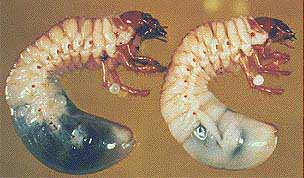Bacterial Agents
Over 90 species of naturally occurring, insect-specific bacteria
have been isolated from insects, plants, and the soil, but only a few
have been studied intensively. The two studied the most have been
Bacillus thuringiensis
and Bacillus
popilliae.
|
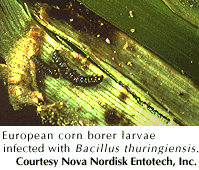
|
Background on Bacillus thuringiensis
Bacillus thuringiensis (Bt) occurs naturally in
the soil and on plants. Bt produces a crystal protein that
is toxic to specific groups of insects. Bt has been
available in North America as a microbial insecticide since
the 1960's. The products have a excellent safety record and
can be used on crops until close to the day of harvest. The
bacteria must be eaten, so good spray coverage of the crops
is essential.
Habitat
Bacillus thuringiensis is found on, and may be
used on many crops. Including, vegetables, cotton, tobacco,
tree crops, and landscaping.
|
Pest controlled
The primary insects controlled by Bacillus thuringiensis
are numerous moth and butterfly caterpillars, as well as, certain
beetle and fly larvae. Different varieties of Bacillus
thuringiensis have been formulated to control certain insects.
For example, the Bacillus thuringiensis variety
kurstaki controls many caterpillar pest such as horn worms,
bag worms, and cabbage worms to name a few. The variety
israelensis is used to control mosquito, black fly and certain
gnat larvae. When purchased commercially, many of the varieties are
combined to attack a broader spectrum of pest.
How it works
The commercial product is applied to the crops by
spraying the crops with a solution containing the
Bacillus thuringiensis . A susceptible insect ingest
the bacteria when the insect ingest the treated crop. The
crystal protein toxin damages the gut lining, which leads to
gut paralysis. This affectively stops the insect from
feeding. The combined effects of gut lining tissue damage
and starvation causes death. There are disadvantages in
using this control. The insect not only must be in a
susceptible stage of development, but the insect must also
ingest enough of the bacterium to cause sufficient damage.
Genetic engineers have also developed several plant species
to express the Bacillus thuringiensis toxin as part
of the plant's normal development. This leads to genetically
engineered "insect-resistant"
crops.
|
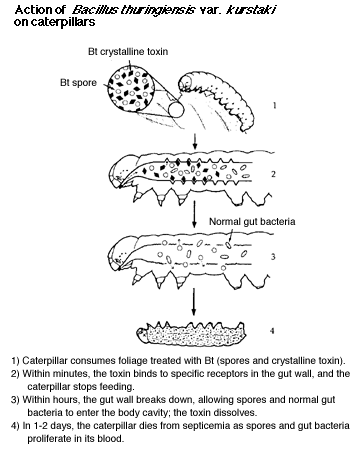
|
Effectiveness
Successful use of Bacillus thuringiensis formulations
requires application to the correct target species of pest at a
susceptible stage of development, in the right concentration, at the
correct temperature to ensure feeding, and before the pest enter the
plant or fruit where they would be protected. As with any microbial
insecticide, determining when the pest is most susceptible is the key
to getting the best results.
- Negatives
- Insects have to be in a susceptible stage of development
- Some species of pest have evolved resistance to certain
varieties of Bacillus thuringiensis that used to work
against them.
- Bacillus thuringiensis formulations may be deactivated
in sunlight and may be effective for only a few days after
application.
- Rain and watering the crops can wash away the Bacillus
thuringiensis from crop foliage.
- Positives
- Bacillus thuringiensis do not usually spread to other
insects or cause disease outbreaks on their own as occurs with
many other microbiological controls.
- Combined varieties of Bacillus thuringiensis are
effective against a broad range of insects.
- Use of Bacillus thuringiensis reduces need to use
chemical pesticides.
Habitat
Bacillus popilliae prefer nutrient rich media containing a
yeast extract, an amino acid source, and sugars. When used as a
pesticide, it is typically spread onto the turf so it can soak into
the underlying soils.
|
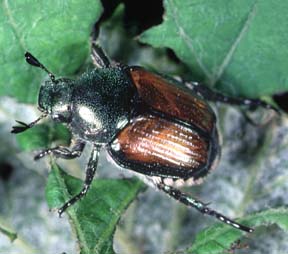 Japanese
beetle adult. PHOTO: Mindy Proscia Japanese
beetle adult. PHOTO: Mindy Proscia
|
Pest controlled
The Japanese beetle, Popillia japonica, is the
specific insect that Bacillus popilliae controls.
Other varieties of Bacillus popilliae have been found
to work on other beetles in the family Scarabeaidae, which
include the Japanese beetle, the chafers (a pasture pest)
and the beneficial dung beetles.
|
How it works
A commercial product, such as "milky
spore", is applied to the turf using a tube applicator as seen
below. After application, the larval grubs ingest the spores of
Bacillus popilliae when they ingest the roots of the
grass. The bacteria begins to multiply inside the gut of the grub
killing it in about 14 days. Once the grubs begins to decompose,
billions of new bacteria are released into the soil. The treatment
begins working upon application wherever grubs are feeding. Warm
climates can achieve complete control in 2-3 years. Colder climates
may require 3-5 years. Once the treatment is applied and established
in your lawn it can be effective for 15 to 20 years. The cause of
death is most likely physiological starvation caused by the growth of
bacterial cells in the hemolymph.
|
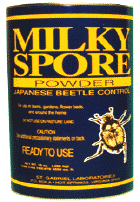
|
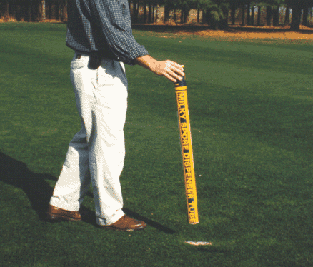
|
Effectiveness
The treatment is most effective when applied on a region or state
wide basis to reduce the overall levels of beetle infestation. It is
less effective when used by small landowners, who may control larvae
in their own turf only to have their plants eaten by beetles from
neighboring properties.
- Negatives
- High cost due to the cost of production
- Slow rate of action, usually taking 2-5 years
- Very specific host damage, mainly Japanese beetles and a few
other Scarabeaidae
- Need to treat large areas
- Developing resistance in pest species
- Positives
- Very specific host damage, mainly Japanese beetles and a few
other Scarabeaidae
- Complete safety for man and other vertebrates
- Compatibility with other control agents
Top of page
© 2000 Julie Vidic, Dan
Shields and Bryan Pennix. All Rights Reserved, except for the images,
which retain their own copyrights.
This site was designed by Julie Vidic, Dan Shields and Bryan Pennix
for MBI 699.W in August of 2000.
